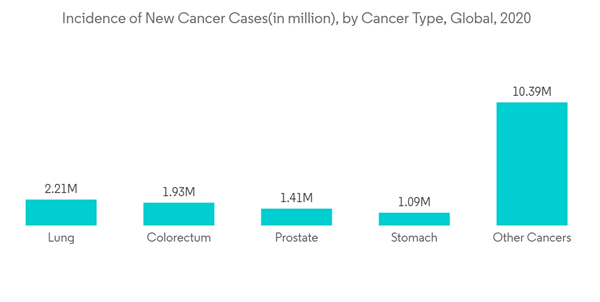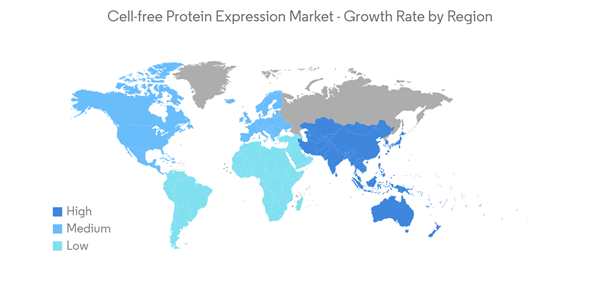The Global Cell-free Protein Expression Market size is estimated at USD 266.82 million in 2024, and is expected to reach USD 354.38 million by 2029, growing at a CAGR of 5.84% during the forecast period (2024-2029).
The market has a slightly positive impact due to the pandemic. Moreover, according to the article, "Harnessing proteomics could improve therapeutic approaches to COVID-19," published in November 2020, the development of therapeutic and preventive strategies requires an accurate understanding of proteins' role in the SARS-CoV-2 infection process and progression of COVID-19.
Furthermore, according to the article, "Scientists develop a high-throughput, cell-free screening platform for anti-SARS-CoV-2 antibody discovery," published in November 2021, Therapeutic monoclonal antibodies developed against the spike protein of SARS-CoV-2 have become a promising intervention to treat severely ill coronavirus disease 2019 (COVID-19) patients. However, the isolation, evaluation, and identification of the best antibody candidate require a series of time-consuming and labor-intensive experiments, including cloning, transfection, cell-based protein expression, protein purification, and critical assessment.
The significant factors for the growth of the cell-free protein expression market include the increasing R&D in proteomics and genomics, high prevalence of cancer and infectious diseases, and shorter-expression time and structural modification. Cell-free protein expression employs cell lysates to produce the desired recombinant proteins. The primary advantage of this technique is the aversion of workflow hurdles of maintaining cell culture or living cells. Cell lysates are produced by the breakdown and use of cellular components of eukaryotic or bacterial cells. Several cell-free protein expression systems are currently commercially available, based on E. coli, rabbit reticulocytes, wheat germs, human cell lines, and insect cells.
According to the article, 'Exploring the Potential of Cell-Free Protein Synthesis for Extending the Abilities of Biological Systems,' published in October 2019, Cell-free protein synthesis (CFPS) has the potential to overcome loopholes in the current in vivo production systems and is a promising tool in both primary and applied scientific research. It facilitates a simplified organization of desired experiments with various reaction conditions, making CFPS a powerful tool in biological research. It has been used to expand genetic code, assembly of viruses, and metabolic engineering to produce toxic and complex proteins. Subsequently, CFPS systems have emerged as a powerful technology for the high-throughput production of membrane proteins, enzymes, and therapeutics.
An in vitro protein expression system has significant advantages over living cell-based protein expression, including a shorter duration of the process, isotopic labeling of proteins, incorporation of non-natural amino acids, and optimization of protein complexes. In addition, the ability to enable high throughput production, the recent trend of more research in personalized medicine, and the growing need for biological therapies to manage cancer is significant driver for the adoption of cell-free protein expression techniques by pharmaceutical and biotechnology firms.
In E. coli-based systems, codons used are different, with some being eukaryotic specific. Additionally, post-translational modifications are not possible, which in turn, limit the system's usage in the synthesis of specific human therapeutics. Significant advancements have been, however, made in order to address these problems. Therefore, the E. coli lysate sub-segment is expected to register a steady growth rate during the forecast period, owing to high adoption rates and recent developments.
In the North American region, the United States holds the largest market share due to factors such as the increasing burden of cancer cases in the country, which is anticipated to stimulate the demand for cell-free protein expression market.
According to Globocan 2020, an estimated 2,281,658 new cancer cases were diagnosed in 2020, and 612390 cancer deaths were reported in the United States. The increasing demand and acceptance of cell-free protein expression in the treatment of diseases such as cancer, rare diseases, and other disorders are also driving the growth of the studied market in the region.
This product will be delivered within 2 business days.
The market has a slightly positive impact due to the pandemic. Moreover, according to the article, "Harnessing proteomics could improve therapeutic approaches to COVID-19," published in November 2020, the development of therapeutic and preventive strategies requires an accurate understanding of proteins' role in the SARS-CoV-2 infection process and progression of COVID-19.
Furthermore, according to the article, "Scientists develop a high-throughput, cell-free screening platform for anti-SARS-CoV-2 antibody discovery," published in November 2021, Therapeutic monoclonal antibodies developed against the spike protein of SARS-CoV-2 have become a promising intervention to treat severely ill coronavirus disease 2019 (COVID-19) patients. However, the isolation, evaluation, and identification of the best antibody candidate require a series of time-consuming and labor-intensive experiments, including cloning, transfection, cell-based protein expression, protein purification, and critical assessment.
The significant factors for the growth of the cell-free protein expression market include the increasing R&D in proteomics and genomics, high prevalence of cancer and infectious diseases, and shorter-expression time and structural modification. Cell-free protein expression employs cell lysates to produce the desired recombinant proteins. The primary advantage of this technique is the aversion of workflow hurdles of maintaining cell culture or living cells. Cell lysates are produced by the breakdown and use of cellular components of eukaryotic or bacterial cells. Several cell-free protein expression systems are currently commercially available, based on E. coli, rabbit reticulocytes, wheat germs, human cell lines, and insect cells.
According to the article, 'Exploring the Potential of Cell-Free Protein Synthesis for Extending the Abilities of Biological Systems,' published in October 2019, Cell-free protein synthesis (CFPS) has the potential to overcome loopholes in the current in vivo production systems and is a promising tool in both primary and applied scientific research. It facilitates a simplified organization of desired experiments with various reaction conditions, making CFPS a powerful tool in biological research. It has been used to expand genetic code, assembly of viruses, and metabolic engineering to produce toxic and complex proteins. Subsequently, CFPS systems have emerged as a powerful technology for the high-throughput production of membrane proteins, enzymes, and therapeutics.
An in vitro protein expression system has significant advantages over living cell-based protein expression, including a shorter duration of the process, isotopic labeling of proteins, incorporation of non-natural amino acids, and optimization of protein complexes. In addition, the ability to enable high throughput production, the recent trend of more research in personalized medicine, and the growing need for biological therapies to manage cancer is significant driver for the adoption of cell-free protein expression techniques by pharmaceutical and biotechnology firms.
Cell-free Protein Expression Market Trends
The E. Coli Lysate Segment of the Lysate Systems is Expected to be the Fastest Growing Segment Over the Forecast Period
E. coli lysates are the most commonly used systems among all available commercial lysate systems. E. coli lysates are devoid of endogenous genetic messages and have advantages, such as very high protein yield and tolerability to most additives. Furthermore, E. coli-based systems are being used in recombinant techniques for the manufacture of various biological therapeutics and insulin. Continuous use has enabled research on interactions and tolerability of the byproducts of E. coli-based systems, and significant present scientific literature enables its rapid adoption by industries and academics.In E. coli-based systems, codons used are different, with some being eukaryotic specific. Additionally, post-translational modifications are not possible, which in turn, limit the system's usage in the synthesis of specific human therapeutics. Significant advancements have been, however, made in order to address these problems. Therefore, the E. coli lysate sub-segment is expected to register a steady growth rate during the forecast period, owing to high adoption rates and recent developments.
North America Dominates the Market, and It is Expected to do Same in the Forecast Period
North America is found to hold a major share in the cell-free protein expression market, and it is expected to show a similar trend over the forecast period, without significant fluctuations. The primary factors behind the large market size include the increasing prevalence of chronic diseases, such as cancer, aging population, growing demand for targeted and personalized medicine, the presence of major R&D facilities, and favorable government initiatives in the United States. There is a growing trend of cell-based research in the US academia and biotechnology industries. In recent years, several government initiatives have been supplementing the growth of the cell-free protein expression market in the United States.In the North American region, the United States holds the largest market share due to factors such as the increasing burden of cancer cases in the country, which is anticipated to stimulate the demand for cell-free protein expression market.
According to Globocan 2020, an estimated 2,281,658 new cancer cases were diagnosed in 2020, and 612390 cancer deaths were reported in the United States. The increasing demand and acceptance of cell-free protein expression in the treatment of diseases such as cancer, rare diseases, and other disorders are also driving the growth of the studied market in the region.
Cell-free Protein Expression Industry Overview
The market studied is a moderately consolidated market, owing to the presence of small and large market players. Some of the market players are biotechrabbit GmbH, CellFree Sciences Co. Ltd, Cube Biotech GmbH, GeneCopoeia Inc., Jena Bioscience GmbH, Promega Corporation, Qiagen NV, Sigma-Aldrich Corporation (Merck KGaA), Takara Bio Inc., and Thermo Fisher Scientific Inc.Additional Benefits:
- The market estimate (ME) sheet in Excel format
- 3 months of analyst support
This product will be delivered within 2 business days.
Table of Contents
1 INTRODUCTION
4 MARKET DYNAMICS
5 MARKET SEGMENTATION
6 COMPETITIVE LANDSCAPE
Companies Mentioned (Partial List)
A selection of companies mentioned in this report includes, but is not limited to:
- Biotechrabbit GmbH
- CellFree Sciences Co.,Ltd.
- Cube Biotech GmbH
- GeneCopoeia, Inc.
- Jena Bioscience GmbH
- Promega Corporation
- Creative Biolabs
- Merck KGaA
- Takara Bio Inc.
- Thermo Fisher Scientific Inc.
- New England Biolabs
- Bioneer Corporation
- Otsuka Holding Co. Ltd. (Cambridge Isotope Laboratories Inc.)
- LenioBio GmbH
- Sutro Biopharma Inc
- Addgene Inc.
Methodology

LOADING...










